Introduction
Microservices architecture has revolutionized the way applications are built and deployed, offering businesses the ability to develop, scale, and maintain independent services. This architectural approach, likened to a bustling city with standalone buildings, empowers organizations to adapt rapidly in the ever-evolving digital age. In this article, we will explore the concept of microservices, compare it to traditional monolithic architecture, and delve into the benefits it brings to the e-commerce industry.
We will also examine how microservices enhance scalability, flexibility, resilience, and market adaptation. Additionally, we will explore the role of microservices in headless commerce, API-first approaches, and cloud-native development. Finally, we will discuss best practices for adopting microservices, common challenges, and solutions, as well as how microservices future-proof e-commerce platforms.
Join us on this journey as we unravel the power of microservices and their impact on the e-commerce landscape.
What are Microservices?
Microservices architecture is akin to a bustling city, each building functioning as a standalone unit, delivering specific services such as healthcare, education, or retail. In this architectural approach, applications are constructed as a network of these independent services, each dedicated to a particular business goal and capable of being developed, deployed, and scaled in isolation.
Consider the tale of Allegro, one of Central Europe's largest e-commerce platforms. As it grew, the company faced development bottlenecks due to its monolithic codebase. Transitioning to a microservices architecture allowed Allegro to evolve different aspects of its application at unique paces, fostering innovation and agility.
Similarly, the Dunelm Group, a leader in UK homewares retail, leverages microservices to support its substantial online presence, which is responsible for a significant portion of its revenue. Microservices have enabled Dunelm to mirror its organizational and digital platform expansion, ensuring seamless frontend experiences for its customers.
TotalEnergies Digital Factory (TDF), a subsidiary of the global energy giant, also utilizes microservices to develop tailored digital solutions, with over 80 solutions deployed in 25 countries. APIs are the linchpin of TDF's strategy, modernizing legacy systems and propelling the company's digital transformation.
The microservices approach is characterized by its modularity. Each service operates independently, akin to LEGO bricks, which can be assembled and reconfigured without impacting the overall structure. This independence is instrumental in allowing development teams to focus on specific areas of an application, enhancing efficiency and reducing the risk of widespread system disruptions during updates.
While monolithic architectures resemble a grand castle with interconnected rooms, they pose significant scaling challenges as businesses grow. Microservices architecture, with its distributed approach, offers a compelling alternative, enabling organizations to scale specific components as needed, much like expanding a city by adding new buildings rather than enlarging existing ones.
In essence, microservices are the building blocks of modern, scalable, and resilient applications, a testament to the evolving landscape of software development and the quest for architectural solutions that cater to the dynamic needs of businesses in the digital age.
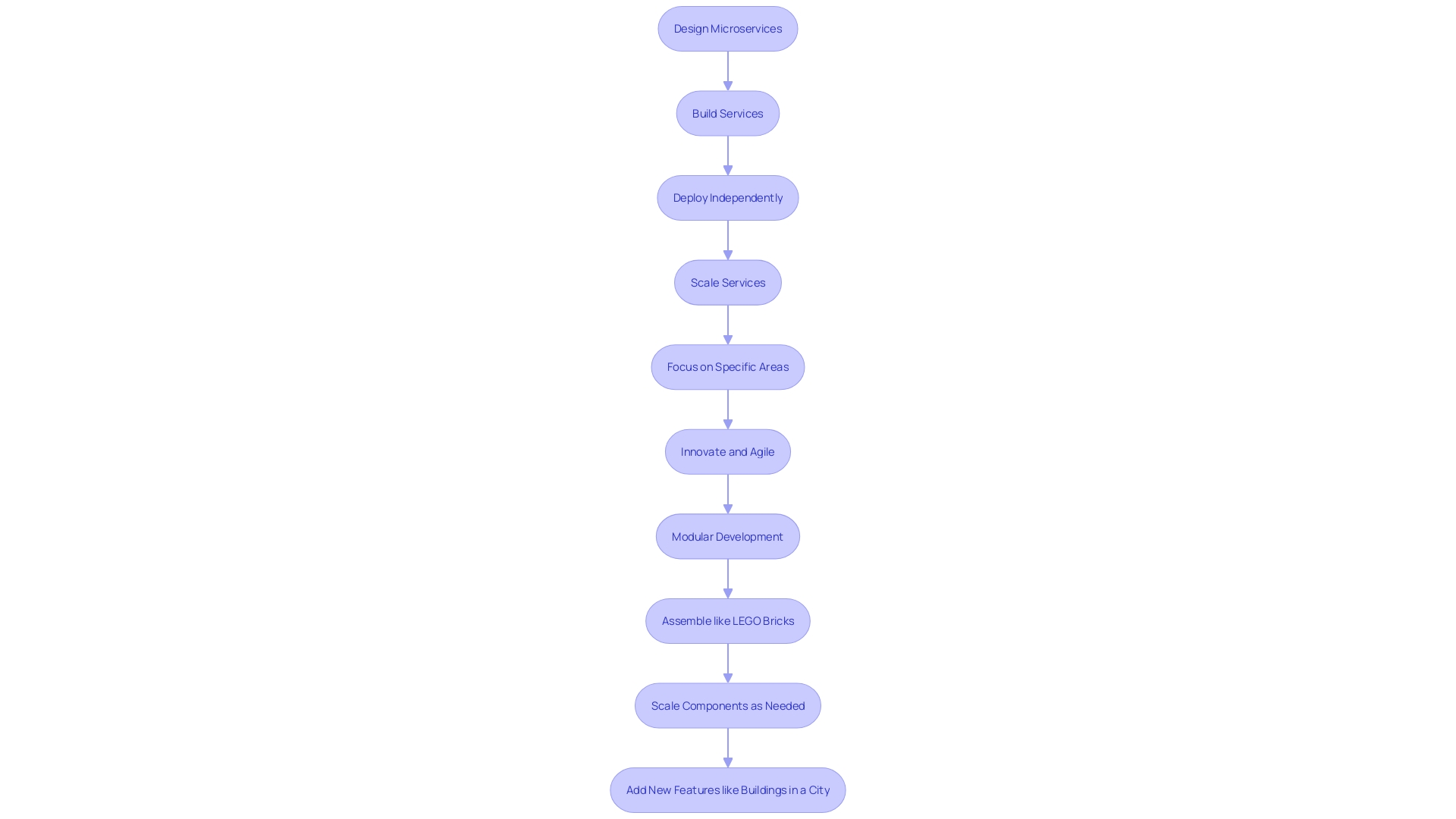
Comparison: Monolithic vs. Microservices Architecture
Choosing the right architectural style is a pivotal decision when building an app, as it impacts development, maintenance, and scalability. The traditional monolithic architecture designs software as a unified entity, with a single codebase and tightly coupled components sharing the same database. Alterations in one segment often necessitate adjustments throughout the system, similar to a large, indivisible black box.
Conversely, microservices architecture adopts a modular approach, breaking down applications into smaller, autonomous services akin to LEGO bricks. These services operate independently, communicating via APIs, which reduces interdependency and facilitates more straightforward updates and maintenance. This architectural style is characterized by loose coupling, allowing for each service to be maintained without affecting others, and interoperability, ensuring seamless interaction among services and with other systems across diverse platforms and technologies.
The debate between monolithic and microservices architectures is ongoing, with each offering unique benefits tailored to specific application needs and functionalities. The evolution of software development continues to refine these architectures, influencing their adoption in various scenarios.

Benefits of Microservices in E-commerce
Microservices, characterized by their independence and modularity, present a compelling solution for e-commerce platforms looking to harness flexibility and scalability. With a microservice architecture, each component is developed, deployed, and scaled as a standalone unit, promoting a more manageable development process.
Consider the case of the Dunelm Group, a leading UK homewares retailer. As their digital platform expanded, mirroring the company's growth, they needed to adopt an architecture that could sustain high traffic volumes and support their revenue-generating website. By employing a microservices approach, they could enhance the frontend layer to be as robust and customer-centric as possible.
Moreover, Bosch's creation of the solid oxide fuel cell (SOFC) system, backed by a digital twin, illustrates the power of microservices in optimizing performance over a system's lifetime. This approach ensures high efficiency and low emissions through independent, scalable services, each with a focused functionality.
Netflix's transition from a monolithic to a microservice architecture further emphasizes the benefits of this approach. As the company scaled, microservices allowed for better handling of complexity, enabling them to provide a seamless streaming experience to millions of users worldwide.
In the realm of software architecture, the decision between monolithic and microservices architectures has significant implications. Microservices offer a more granular level of control, akin to managing a collection of LEGO bricks as opposed to a single, unwieldy black box. This analogy helps clarify the contrast between the two, highlighting the ease of updating and maintaining individual services within a microservices architecture.
The e-commerce industry continues to evolve, with customers expecting personalized experiences and frictionless navigation. Integrating microservices can facilitate the creation of dynamic, user-centric features, such as 'recommended for you' sections, enhancing customer engagement and loyalty.
In summary, microservices architecture provides a strategic advantage in building responsive, resilient, and customer-focused e-commerce platforms. Its independent service model enables businesses to adapt rapidly to market demands, ensuring continued growth and customer satisfaction.
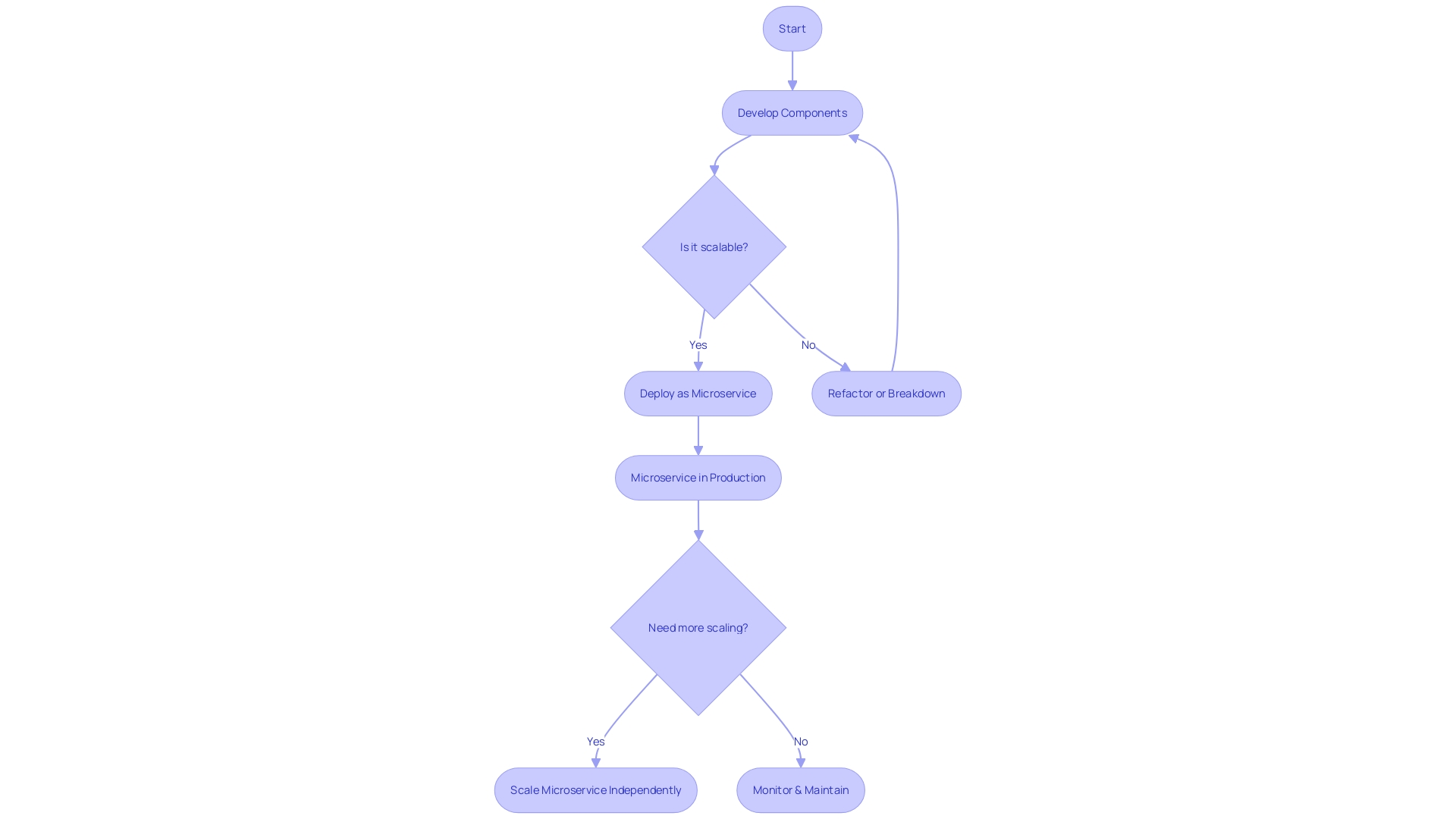
Enhanced Scalability
Utilizing a microservices architecture is akin to constructing a versatile puzzle where each piece can be strategically scaled according to user demand. This modular approach was exemplified by PayPal in its infancy. The online payment giant faced a tidal wave of traffic as their user base expanded, prompting them to reinforce their infrastructure. This initial solution of scaling with additional hardware was soon eclipsed by the need for a more sustainable approach as they surpassed a million transactions daily. They adapted by distributing their workload across over a thousand virtual machines, a precursor to the microservices philosophy.
Similarly, Dunelm Group, the UK's top homewares retailer, experienced the need to evolve their digital platform in alignment with their growth. This led to a transition towards a microservices architecture for their backend systems, catering to the over 400 million sessions their website handles annually.
Netflix's journey from a monolithic to a microservices architecture illustrates the transformative impact this change can have. As they shifted to microservices, they benefited from enhanced flexibility, allowing them to deliver content seamlessly and maintain performance during high-traffic events.
The architecture of cloud services further supports the microservices model, offering a compendium of compute resources that can be individually scaled. This eliminates the constraints of a monolithic approach, providing a foundation where services are not just interdependent components but individual entities capable of independent scaling and evolution.
In essence, microservices architecture is not solely about coding but about architecting a digital ecosystem that aligns with business objectives. It's a strategic move that fosters agility, modularity, and operational efficiency, ensuring that each user enjoys a consistent experience regardless of when or where they access the application.

Improved Flexibility
Microservices architecture, by design, offers the freedom to select the most suitable technology stack for each individual service. This approach stands in stark contrast to monolithic systems, where all components are tightly interwoven and must adhere to a single technology stack. The microservices model presents a myriad of advantages, particularly in its ability to capitalize on the best tools and languages optimized for each service's requirements. For example, Instagram's remarkable growth to 14 million users within a year was enabled in part by adhering to principles that echo the benefits of a microservices architecture such as simplicity and a dependable tech stack, even with a minimal engineering team.
Moreover, established companies like Dunelm Group plc recognize that scaling a digital platform that accounts for a significant portion of their revenue requires an architectural evolution. By transitioning to a microservices backend, they can better reflect their growth structurally and technically. Similarly, at Netflix, the Java Platform team, led by experts like Paul, a seasoned Java developer and author, focuses on providing a robust set of tools for Java microservices. This dedication to specialized, high-quality microservice development is indicative of the wider industry's move towards modularity.
Microservices empower businesses to develop, deploy, and scale services independently, leading to improved agility and efficiency in the software development lifecycle. As the tech industry continues to expand and adapt, with a plethora of tech business ideas flourishing in 2023, the shift towards microservices is becoming increasingly prevalent. This transition allows companies to respond swiftly to market changes and customer needs, ensuring they stay at the forefront of technological innovation.
Increased Resilience
The architecture of microservices offers a robust solution to ensuring that an e-commerce platform remains resilient in the face of partial system failures. By design, microservices operate independently, which means that if one component encounters an issue, the others can continue to function without being affected. This independent operation provides a level of fault tolerance that is crucial for maintaining service availability and business continuity.
For instance, Amazon ECS (Elastic Container Service) leverages this architecture to maintain high availability. Amazon's approach assumes that failures are inevitable, even in systems with high reliability. With millions of servers running, they expect a certain number of failures at any given time, but their design allows the rest of the system to operate smoothly despite these issues.
In the retail sector, companies like Dunelm Group plc rely heavily on their digital platforms, which are responsible for a substantial portion of their revenue. As they scale, their system's architecture, including the frontend layer that directly impacts customer experience, must evolve. Microservices enable this by allowing individual services to scale independently based on demand.
Moreover, the concept of rate limiting is integral to microservices architecture. This involves controlling the flow of requests to prevent system overload, akin to the way access gates manage the flow of commuters during peak hours at a subway station. This ensures stable operation by only allowing a certain number of requests through within a specified timeframe.
Notably, David Farquharson, CEO of iONLINE Connected Networks, emphasizes the importance of network resilience, likening it to fuel for a car. Without resilience, a business's operations can grind to a halt, impacting availability, brand reputation, and financial performance. Microservices architecture contributes to this resilience by compartmentalizing potential points of failure, thus safeguarding the network against widespread issues.
In summary, microservices architecture is not just a technical choice but a strategic one that enhances the reliability of e-commerce operations. It empowers businesses to detect, respond, recover, and adapt to faults and challenges while maintaining seamless functionality for their customers.
Faster Market Adaptation
Microservices architecture has emerged as a transformative force in building responsive and scalable e-commerce platforms. By breaking down applications into smaller, independent services, each focused on a specific business function, microservices enable organizations to enhance agility and accelerate time-to-market. For instance, Dunelm Group plc, a leading UK homewares retailer, leverages microservices to manage its substantial digital platform traffic effectively, contributing to around 35% of the company's revenue. Similarly, Bosch's implementation of a digital twin to support its solid oxide fuel cell system showcases how microservices can optimize cost and performance over a product's lifetime by monitoring and visualizing process parameters.
TBC Bank's agile transformation exemplifies the organizational benefits of microservices, such as reduced complexity and faster digital product delivery. These case studies illustrate the versatility and strategic value of microservices in adapting to market trends and customer needs. With retail executives prioritizing technology deployment, as reported by Retail Technology Review, and Amazon India leveraging its Great Indian Festival to showcase sales agility, the importance of microservices in e-commerce is more pronounced than ever. The architecture's modularity and specialization principles ensure that businesses can rapidly scale and deploy services, driving innovation and staying competitive in the fast-paced digital marketplace.
Headless Commerce and Microservices
Headless commerce represents a transformative approach in the e-commerce landscape, separating the customer-facing front end from the operational back end. This bifurcation offers a myriad of advantages, allowing businesses to tailor the user experience without altering core functionalities. Microservices architecture plays an integral role in this separation, acting as the backbone that sustains the head-end by delivering essential services.
Dunelm Group plc's experience exemplifies the successful implementation of a headless commerce strategy, which has been pivotal in their digital platform's ability to attract over 400 million sessions annually, contributing to approximately 35% of the company's revenue. Similarly, embracing a microservices architecture has allowed for the development of innovative features such as the Labels System, which provides an enhanced level of document management tailored to specific editorial teams' needs across various regions.
Moreover, the integration of stages like Regulator, Staging, and Integration in content management further demonstrates the flexibility of headless systems. Each stage serves a unique purpose, from ensuring regulatory compliance to facilitating content testing and integration, showcasing how microservices can streamline e-commerce operations.
The retail industry's continual growth in technology deployment, as indicated by the recent increase from 24% to 36%, underscores the need for scalable and adaptable e-commerce solutions. The transition to headless commerce systems, underpinned by microservices, allows retailers to respond to evolving market trends and customer expectations more effectively.
Finally, considering the broader e-commerce market, which spans across numerous industries and reaches customers globally, the ability to quickly adapt and offer personalized experiences is invaluable. Headless commerce, powered by microservices, is not just a technical architecture; it's an essential strategy for businesses seeking to thrive in the dynamic world of online retail.
How Headless Commerce Works
Headless commerce architecture splits the user interface (front-end) from the business logic and data management (back-end), which are handled by microservices. This separation allows each part to operate independently, connected through application programming interfaces (APIs).
A practical example of this can be seen in a project where a label system was developed to manage document access across different teams. Each US state had its own team of editors working with a common pool of documents, which were available to all until edited or removed by a particular team. Editors could 'fork' documents, creating a local duplicate for editing that wouldn't affect the other states. This is akin to how headless commerce operates, with the front-end allowing for various user interactions without affecting the underlying data and services.
Moreover, the use of microservices in commerce aligns with the concept of a 'composable architecture.'. This approach is like constructing with LEGO; you build systems from small, exchangeable components. Each microservice can be developed, tested, and updated independently, enhancing flexibility and scalability.
The implementation of such architecture is evident in the retail sector. For instance, the integration of self-checkout systems and the deployment of in-store technologies, despite economic uncertainties, shows the adaptability offered by microservices. These systems rely on a headless approach to streamline operations and improve customer experiences.
One notable use case is Walmart's collaboration with POCLab on The Cultureverse, a metaverse project for hip hop's 50th anniversary. Walmart's ability to commission artwork and curate virtual experiences is supported by a composable architecture that allows seamless integration of new technologies and platforms.
As the e-commerce landscape evolves, with over 75 million requests per month seen in some systems, the headless and microservices architecture provides the agility and performance needed to maintain stability and adapt to the ever-changing digital marketplace.
Composable Commerce: Combining Microservices, API-First, Cloud-Native, and Headless Architecture
Composable commerce represents the cutting-edge in e-commerce architecture, merging the power of microservices, API-first approaches, cloud-native development, and headless commerce into one robust, agile framework. It's like working with a set of interlocking building blocks—each microservice is a block, modular and self-sufficient, allowing businesses to construct and adapt their e-commerce systems with unparalleled flexibility. This architectural approach not only facilitates scalability but also ensures that different components can be updated or replaced without disrupting the entire system.
Retailers like Dunelm Group plc have seen the benefits of such systems firsthand. With a significant portion of their revenue coming from their digital platform, they've recognized the necessity of a simplified, unified backend architecture to support their high-traffic frontend. This translates into a seamless customer experience, from browsing to checkout, irrespective of the customer's entry point into the shopping environment.
Recent trends in retail technology deployment, despite economic uncertainties, indicate a steady growth in the adoption of innovative in-store technologies. Self-checkout systems and robust POS transformations have become top priorities, reflecting the importance of streamlined, frictionless purchase experiences that echo the principles of composable commerce.
Moreover, as the Indian e-commerce market surges, giants like Amazon India are leveraging festivals and sales events to offer a vast array of deals, showcasing the importance of a flexible, scalable e-commerce platform to manage high-volume transactions effectively. Flipkart's support for entrepreneurs tells a similar story, where innovative, adaptable e-commerce solutions enable businesses of all sizes to thrive.
When evaluating e-commerce software, it's crucial to consider not only the immediate benefits but also the long-term implications. A future-proof platform—one that's flexible, scalable, and integrates smoothly with other digital solutions—can significantly reduce total ownership costs while ensuring uptime and access to advanced features. As the e-commerce landscape evolves, the agility provided by composable commerce becomes not just a competitive advantage but a necessity for growth and innovation.
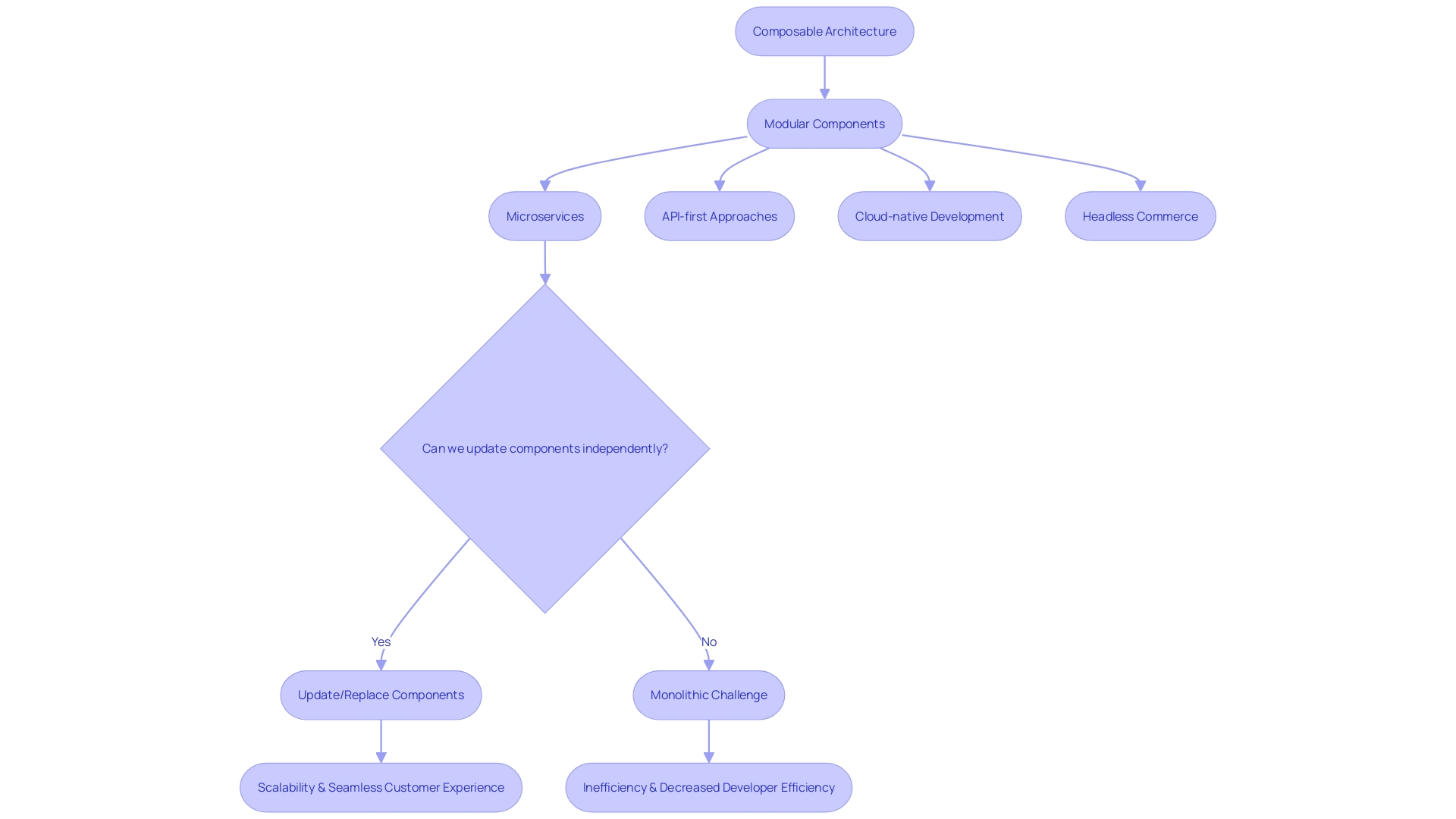
API-First Approach in Microservices
Adopting an API-first approach in e-commerce microservices architecture is more than just a trend; it's a strategic move towards creating a robust and scalable digital foundation. This method prioritizes the development of well-defined APIs, which serve as the primary interface for the microservices architecture. Such a design choice facilitates seamless integration with external systems and positions the e-commerce platform for future growth, allowing for both scalability and flexibility.
Dunelm Group plc, the UK's premier homewares retailer, exemplifies the significance of this approach. As a company whose digital platform accommodates over 400 million sessions annually and accounts for roughly 35% of its revenue, Dunelm recognizes the necessity to evolve its software architecture alongside its business growth. By transitioning from monolithic structures to a microservices-based system, they've been able to ensure that their backend systems are as distributed and adaptable as their ever-expanding enterprise requires.
APIs are akin to the diplomatic channels between the independent kingdoms of software applications, enabling a seamless flow of information and services. By adopting an API-first development strategy, an e-commerce platform can guarantee that its APIs are consistently reliable, reusable, and of high quality. This focus on APIs can result in wider adoption, a developer-friendly environment, and compatibility with a diverse range of applications and systems.
The rise of API-first development is evidenced not only by enterprise narratives but also by industry-wide adoption. This paradigm shift is essential for digital transformation, becoming a fundamental strategy for many successful organizations. As such, e-commerce directors should consider this approach as a cornerstone for building versatile and future-proof digital platforms that can effortlessly accommodate the dynamic nature of online commerce.

Cloud-Native Architecture in Microservices
As software architecture evolves, the move towards microservices has become increasingly popular for its ability to break down applications into smaller, independent services. This architectural style, which communicates through APIs, offers a stark contrast to monolithic architecture where all components are bundled into a single deployment unit. The adoption of a microservices architecture allows companies to be more agile and scalable, adapting quickly to the changing market demands.
For instance, Dunelm Group plc, a leading UK homewares retailer, experienced this scalability first-hand. With over 400 million website sessions annually, contributing to 35% of their revenue, the company's growth necessitated a shift in both their organizational structure and software architecture. By implementing a microservices approach, they could enhance the front end layer of their digital platform, crucial for their online sales.
Similarly, Nubank's journey from a Brazil-based credit card company to a global financial services provider serving 80 million customers underscored the need for a flexible technology foundation. Their cloud-native strategy, built on hundreds of microservices, allowed them to maintain a standardized tech stack while adapting to varied business requirements and diverse regulatory environments across countries.
Industry experts, such as Jonas Boner, have predicted that microservices will continue to shape the cloud-native ecosystem, aligning with the increasing intersection of cloud and edge computing. The rise of Function as a Service (FAAs) and event-driven microservices in cloud-native applications is indicative of this trend, pushing services closer to data sources to minimize latency and enhance performance.
The 2024 Docker State of Application Development Report further corroborates the shift towards microservices. The survey, which gathered insights from professionals ranging from hobbyists to employees at large corporations, revealed a growing preference for microservices architectures, especially when managing out-of-control codebases in complex monoliths.
In conclusion, the transition from monolithic to microservices architecture is not merely a technical decision but a strategic move to support scalability, flexibility, and resilience in cloud-native environments. The success stories of companies like Dunelm and Nubank, along with industry predictions and statistics, underscore the transformative potential of microservices in today's digital landscape.
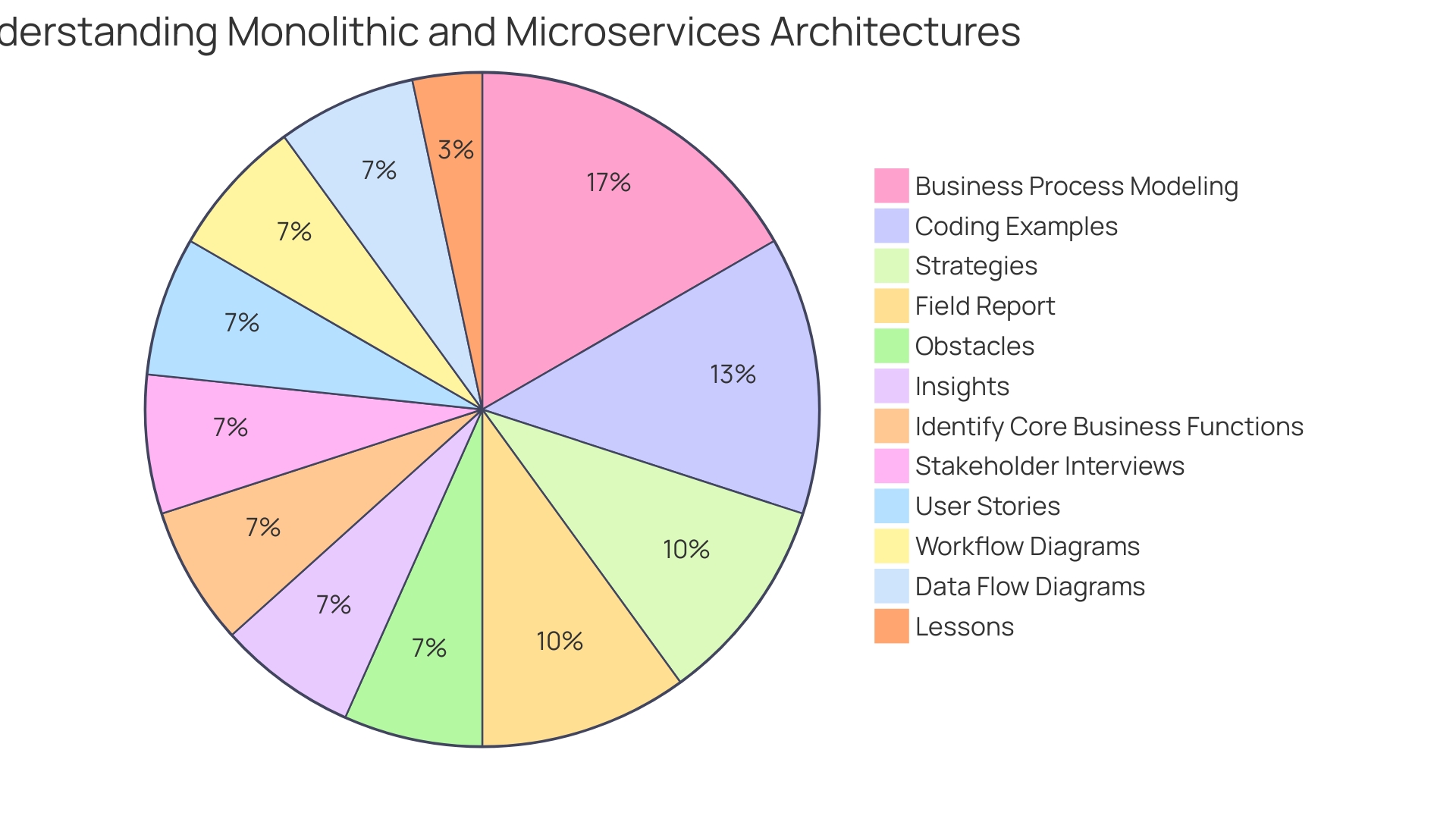
Implementing Microservices in E-commerce: A Step-by-Step Guide
When it comes to adopting microservices architecture in e-commerce, envision the process as evolving from a monolithic library to a network of specialized sections. Initially, an e-commerce platform might be like a 'monolithic library' where everything is central and in one location, which seems manageable when the platform is small. However, as the platform grows, just like a library, it can become a labyrinth, making it difficult to introduce changes without affecting the entire system.
Taking cues from a real-world .NET project, the journey begins with identifying and separating functionalities into distinct microservices, each handling a specific task. This approach offers scalability and easier maintenance. By using technologies like .NET 8 API and Entity Framework Core, the system becomes robust, leveraging the latest features for optimal performance.
Reflecting on Dunelm Group plc's transition, a successful e-commerce platform with a significant portion of revenue generated online, highlights the importance of reimagining the backend architecture to accommodate growth. The implementation of microservices on the backend complements the frontend's needs, especially in high-revenue scenarios.
TotalEnergies Digital Factory's experience further underscores the significance of APIs in modernizing legacy systems, demonstrating the role of microservices in supporting digital transformation across various operational needs in over 25 countries.
In addition, keeping abreast with retail systems news reveals the continuous evolution of e-commerce technology, from checkout-free stores using Zippin technology to the growing importance of self-checkout systems, which are priorities for retailers. These innovations exemplify the dynamic nature of the retail landscape and the necessity for microservices to enable such advancements.
As you embark on this transformative journey, remember that it's not just about technology but also aligning your e-commerce platform's architecture with strategic business objectives. With a microservices approach, updating a section or adding new features becomes an operation isolated to that specific service, minimizing disruption and maximizing agility.
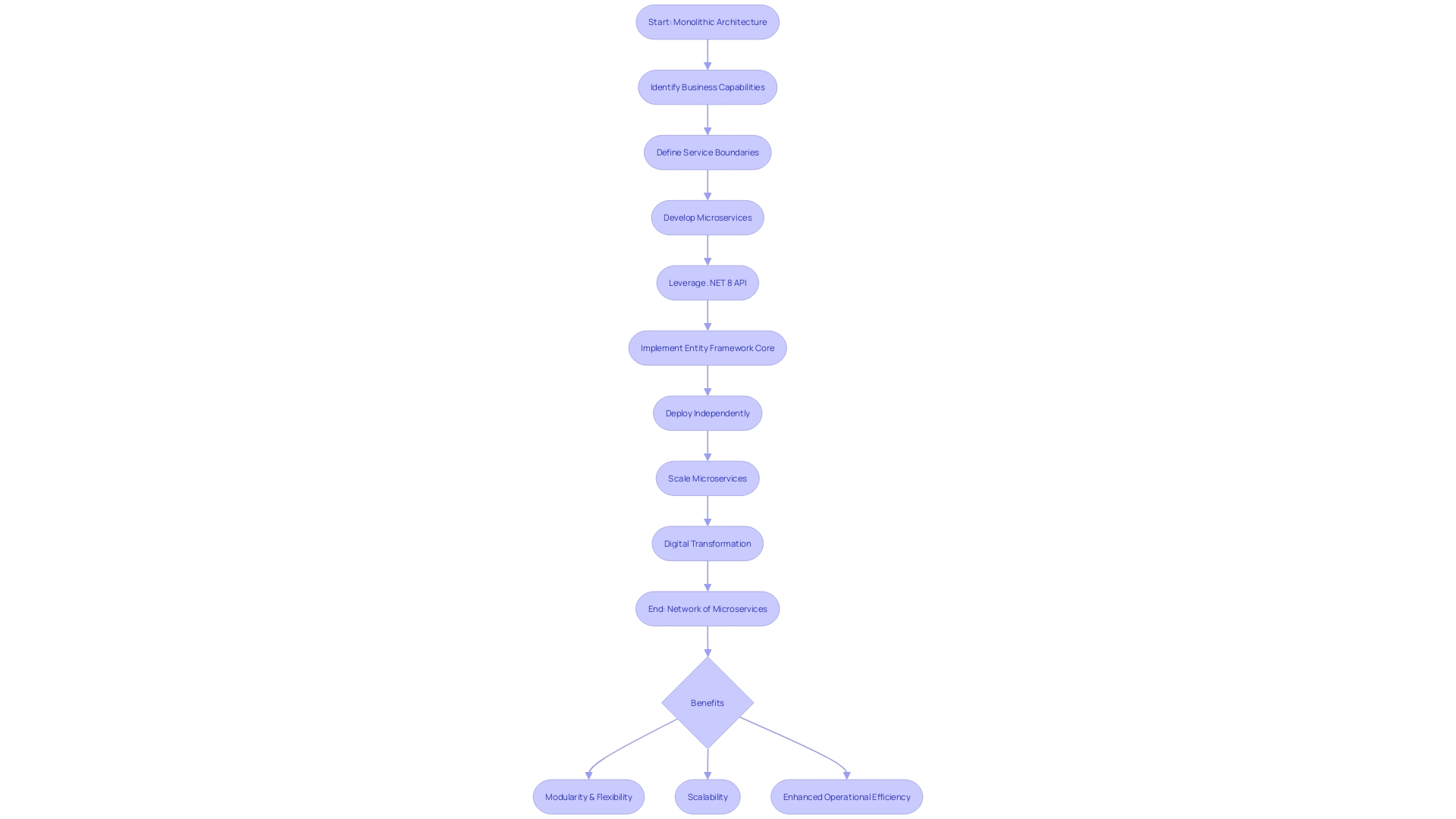
Best Practices for Adopting Microservices
To ensure the successful adoption of microservices in e-commerce, it's essential to understand the nuances of different architectural strategies. A monolithic architecture might be simple to deploy in the early stages of development, but as your e-commerce platform expands, this tightly coupled system can become a bottleneck, inhibiting scalability and complicating updates. On the other hand, a microservices architecture offers the agility to develop, deploy, and scale services independently, akin to constructing a complex system with interoperable LEGO bricks, each with a distinct function.
For instance, the Dunelm Group, a leading UK homewares retailer, faced the challenge of translating their physical retail success to their digital platform, which drives a substantial portion of their revenue. They recognized the need to restructure their software architecture to reflect their organizational growth, moving to a distributed system with a focus on microservices backend architecture.
Drawing from industry expert Eleftheria's insights, the first step towards a microservices-based application is a deep dive into the business process. It involves identifying core functions, engaging stakeholders for detailed requirements, crafting user stories, and visualizing workflows and data flows through diagrams. These practices are fundamental to aligning the microservices with the business objectives, ensuring each service is purpose-built to perform its function efficiently.
Moreover, survey data indicates that e-commerce shoppers are increasingly influenced by discounts and social media, suggesting that microservices need to support dynamic pricing strategies and integrate seamlessly with social platforms to capitalize on these trends.
Adopting microservices in e-commerce isn't merely a technical decision; it's a strategic move that requires careful consideration of business processes, stakeholder needs, and consumer behavior. By embracing microservices, e-commerce platforms can ensure scalability, flexibility, and the ability to innovate rapidly in response to market demands.
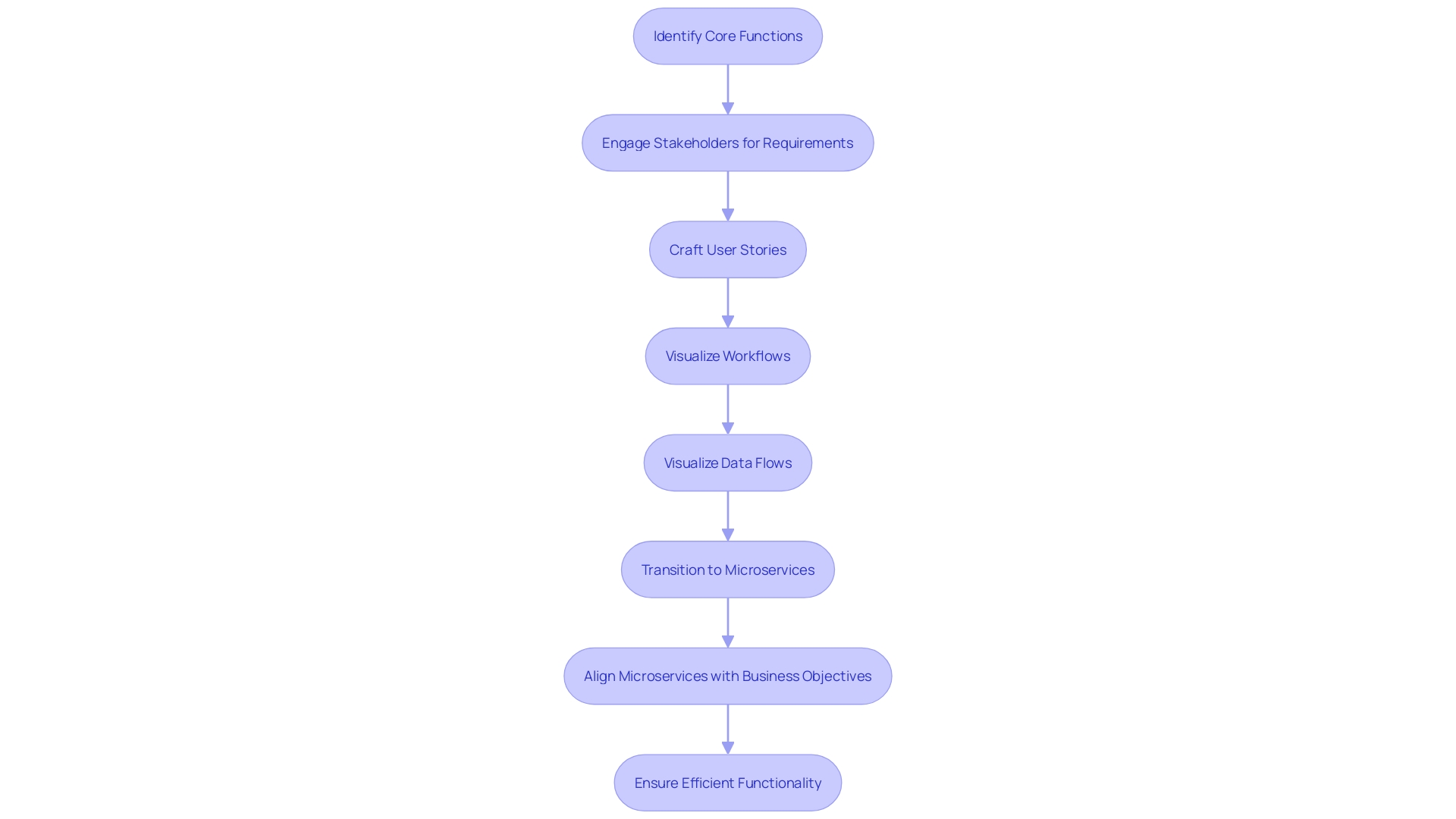
Common Challenges and Solutions
Transitioning to microservices architecture is a strategic move for e-commerce businesses aiming for greater scalability and agility. However, this shift brings its own set of challenges. A common obstacle is managing the complexity that comes with the distribution of services. Each microservice operates independently, requiring its own framework for design, deployment, and scaling.
For example, Dunelm Group plc, a major UK homewares retailer, faced the need to adapt their frontend layer to support their significant online revenue stream, as they transitioned to a distributed systems model. Similarly, TotalEnergies Digital Factory, a subsidiary supporting TotalEnergies' digital transformation, utilizes APIs to modernize legacy systems, driving home the importance of a flexible and adaptable infrastructure in large-scale operations.
Recent industry news highlights the relentless innovation in retail technology, such as the opening of the first checkout-free store in Ireland, showcasing the continuous evolution of customer interaction and payment processing. This underscores the necessity for e-commerce platforms to be highly adaptable and scalable, qualities that microservices architecture can provide.
It's crucial to understand that microservices architecture involves breaking down an application into smaller, loosely coupled services, each with a specific function. While this can initially lead to development bottlenecks, the long-term benefits include ease of scalability and the ability to independently update or improve parts of the system without affecting the whole.
Engaging with the latest industry discussions and case studies, such as those from the RTIH Innovation Awards, can provide valuable insights into successful strategies and common pitfalls, allowing for a smoother transition to microservices for e-commerce platforms.
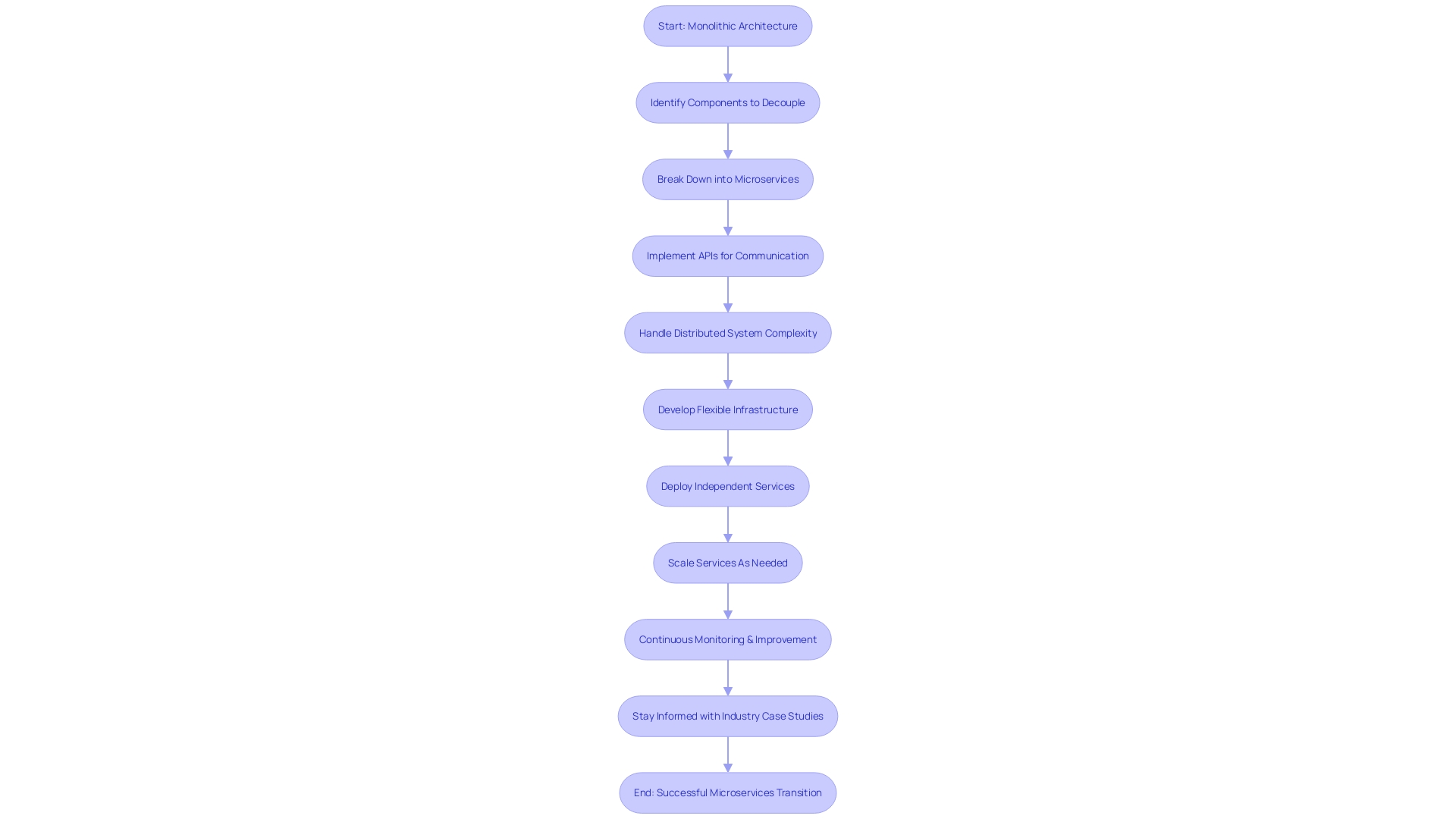
Future-Proofing Your E-commerce Platform with Microservices
The adoption of microservices in e-commerce is akin to constructing a vast digital marketplace with LEGO bricks rather than a single, unyielding monolith. It's a strategic approach that recognizes the distinct advantage of being able to adapt swiftly to technological advancements and ever-shifting market demands. As businesses like Dunelm Group plc have seen, with their digital platform contributing to a significant portion of revenue, the scalability offered by microservices is crucial. They enable an e-commerce platform to evolve without disrupting the entire system, allowing enhancements and new features to be seamlessly integrated into the infrastructure.
Likewise, PayPal's journey from a burgeoning online payment service to handling a million transactions daily underscores the necessity of an adaptable architecture. Their expansion to over a thousand virtual machines was a testament to the robustness required to support rapid growth. Similarly, e-commerce platforms today must be resilient and flexible enough to handle such surges in traffic and transactions.
Microservices are not just a backend revelation but also have profound implications for the frontend layer, especially for companies that heavily rely on their websites for revenue generation. The modular nature of microservices means that each component or service can be developed, deployed, and scaled independently, which enhances overall system stability and performance. This architecture offers a solution to the pressing challenge of maintaining website uptime and responsiveness, which is crucial for retaining customer trust and satisfaction.
By embracing microservices, e-commerce platforms position themselves to drive more sales and deliver a frictionless customer experience, crucial in today's competitive digital marketplace. These systems' inherent flexibility and modularity allow businesses to stay agile, prioritize self-checkout and personalized shopping experiences, and ultimately unlock the potential of AI and ML to stay ahead in the e-commerce race.

Conclusion
Microservices architecture has revolutionized e-commerce by offering businesses the ability to develop, scale, and maintain independent services. This modular approach enhances scalability, flexibility, and resilience, allowing organizations to adapt rapidly in the ever-evolving digital age.
Compared to traditional monolithic architecture, microservices provide numerous benefits. They enable specific components to be scaled independently, similar to adding new buildings to a city, ensuring efficient resource allocation. The modularity of microservices allows each service to be developed and deployed in isolation, using the most suitable technology stack for its functionality, promoting flexibility and innovation.
Microservices architecture also enhances resilience by operating independently. If one service encounters an issue, others can continue to function without disruption, ensuring uninterrupted service availability. Moreover, microservices enable businesses to respond quickly to market changes and customer needs, ensuring continued growth and customer satisfaction.
The integration of microservices in headless commerce systems further amplifies their advantages. By separating the front-end and back-end, businesses can customize the user experience without affecting core functionalities. Microservices act as the backbone, delivering essential services and enabling seamless integration with external systems.
Adopting an API-first approach in microservices architecture is crucial for building a robust and scalable digital foundation. Well-defined APIs serve as the primary interface, facilitating smooth integration with external systems and future growth. Embracing cloud-native architecture empowers businesses to be agile and adaptable, responding swiftly to market demands and technological advancements.
To successfully adopt microservices, businesses should follow best practices such as deep-diving into the business process, identifying core functions, and aligning services with business objectives. It is important to address common challenges, such as managing the complexity of distributed services, and stay updated with industry discussions and case studies.
In conclusion, microservices architecture provides a strategic advantage for building responsive, resilient, and customer-focused e-commerce platforms. Its benefits in scalability, flexibility, and resilience empower businesses to thrive in the dynamic digital landscape. By adopting microservices and following best practices, e-commerce platforms can position themselves for success, staying at the forefront of technological innovation and meeting the evolving needs of customers.





